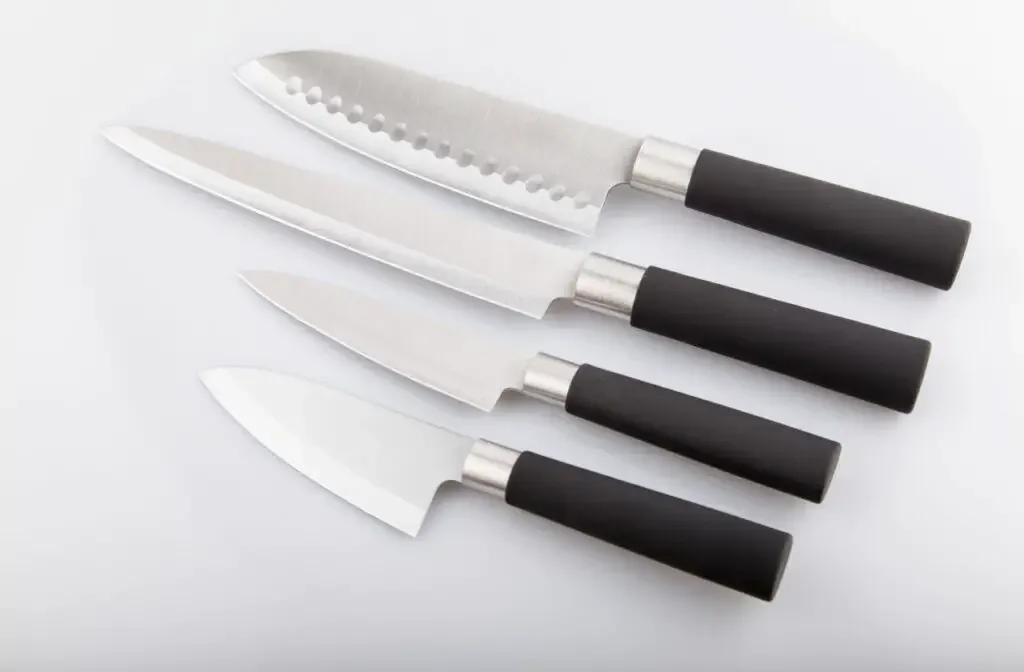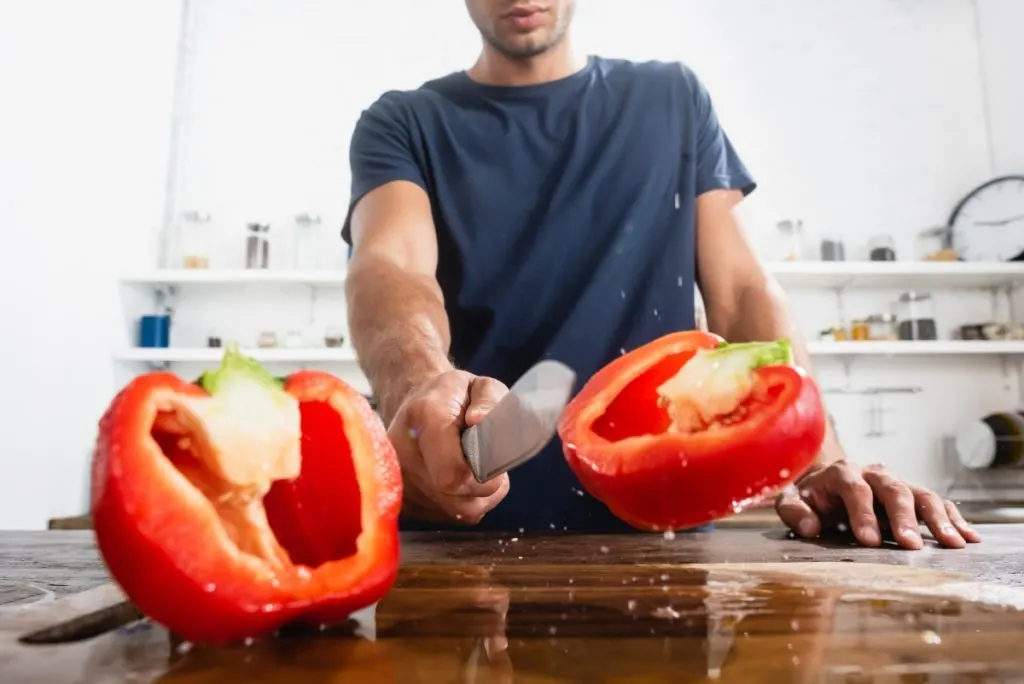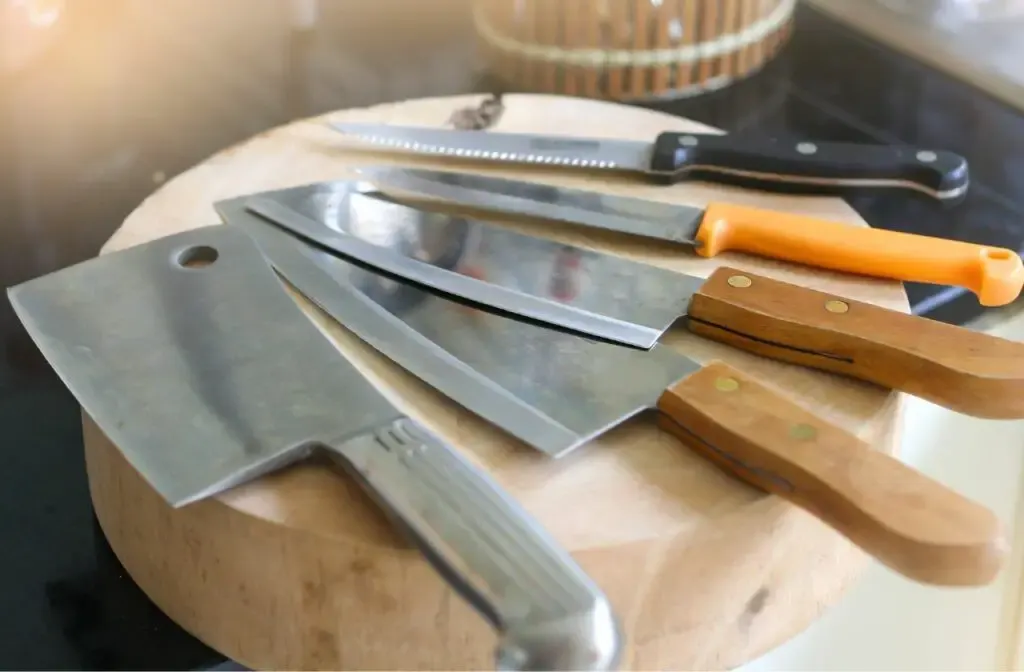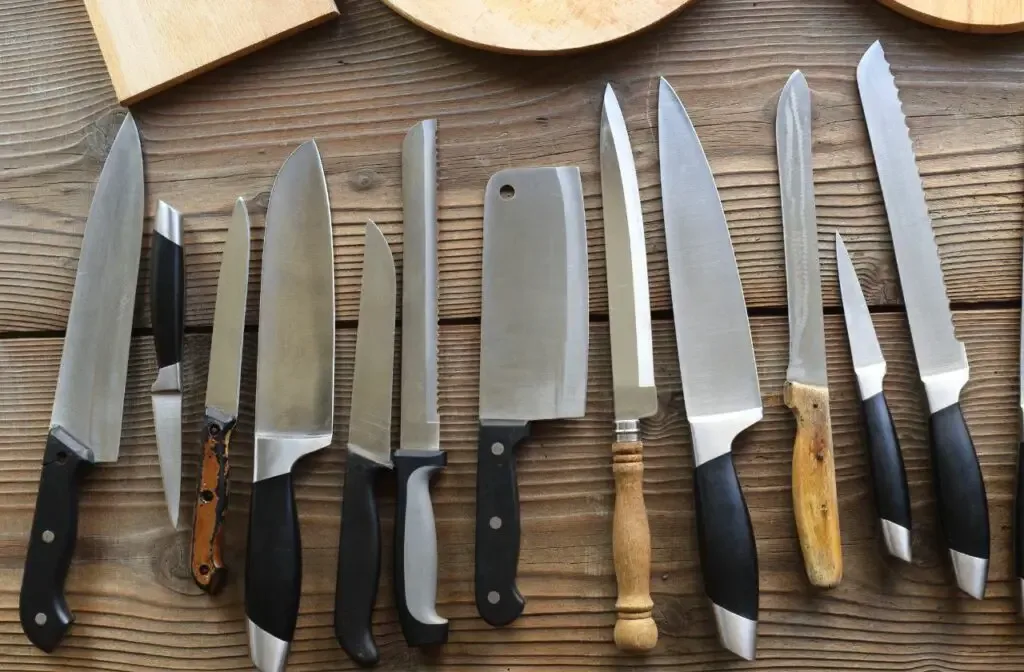As an Amazon Associate, we earn from qualifying purchases with no additional costs for you.
Experiencing the pleasure of using a very sharp knife will make you take your sharpener to all your kitchen knives to reproduce that experience! A sharp knife makes all the effort out of making the cut, but not all knives can hold a sharp edge and stay sharp for a long time. The edge holding of a knife is all about the steel used to make the knife!
A sharp knife with a durable edge is the best tool to have in the kitchen. We recommend the following 3 kitchen knives holding an edge!
- Wusthof Classic High Carbon Stainless Steel Knife
- Yoshihiro VG-10 Hammered Damascus Gyuto Chefs Knife
- Kyocera Advanced Ceramic Professional Chef’s Knife
If an ultra-sharp edge on your knives is important to you in the kitchen, you may be intrigued by our selection of the top 3 kitchen knives that will hold the sharpest edge and stay sharp for a long time! These knives are not only sharp but are top-quality knives that will give great service in any kitchen!
If you are interested in checking out the best kitchen knives we recommend buying knives made by the Wüsthof company. You can find them by clicking here (Amazon link).

What Steel Holds The Sharpest Edge?
Everyone who uses a knife wants the sharpest knife possible to perform the required tasks as quickly and efficiently as possible. Processing food in the kitchen is a particular requirement for sharp knives, not only for efficiency but also to preserve the flavor and integrity of the ingredients.
There are two main choices for the type of steel for your kitchen knives: stainless steel or high carbon steel knives.
Stainless steel manufacturing techniques have come a long way in recent years, and modern stainless steel exhibits characteristics similar to carbon steel; carbon steel still holds the edge over stainless steel.
Historically, stainless steel could not be hardened to the same hardness level as carbon steel, which made carbon steel the best knifemaking steel for holding the sharpest edge. This has, however, changed with the manufacture of high-carbon stainless steel.
For this reason, the most sought-after kitchen knives, namely Japanese kitchen knives, are made from high-carbon steel. Japanese kitchen knives are respected worldwide for their sharpness and edge-holding ability.
Japanese carbon steel is considered the best knifemaking steel in the world for its sharpness and edge durability. These steels can be hardened to a higher degree than most other steel types available in the West.
Western carbon steel knives are also great for a keen edge and would certainly be the primary choice for sharpness over stainless steel, being second only to Japanese carbon steel.
Should You Discount Stainless Steel For Sharp Knives?

As we have discussed, carbon steel knives offer the sharpest and longest-lasting edge for kitchen knives, but does that mean you should discount stainless steel knives as an option?
Modern stainless steel formulations have produced stainless steel knives that are very close to carbon steel blades’ sharpness and edge-holding capacity. These advances in stainless steel have narrowed the gap in edge performance between these two steel types.
These modern stainless steels are called high-carbon stainless steel and can hold an edge that closely matches the edge of traditional high-carbon steel knives.
Many Japanese kitchen knife manufacturers have incorporated modern stainless steel, such as VG-10, into their product range because of these stainless steel types’ high edge retention characteristics.
Some people prefer the convenience and lower maintenance required for stainless steel and choose this steel over carbon steel for this reason and the generally lower cost of stainless steel knives.
Consequently, stainless steel is a valid choice for a knife in the kitchen environment, and if the stainless steel is high-carbon stainless steel, you will have no trouble with the sharpness or edge retention of the blade.
TIP: The right tools to sharpen your knives properly can make all the difference in learning the skill and maintaining your knives. Check out the must-have tools for sharpening your knives in the article below:
3 Must-Have Tools To Sharpen Your Knife Properly (Answered)
What Kitchen Knives Hold The Best Edge?

Carbon steel knives certainly hold a better, sharper edge than stainless steel knives, but steel is not the only option when considering sharp knives in the kitchen.
Japan developed the first ceramic knives in 1997, constructed from an extremely hard and durable material called zirconium dioxide. The only material harder than this ceramic is diamonds. The hardness of the material allows the knife to have an extremely thin and very sharp edge.
While no steel knives can rival ceramic for sharpness, the hardness of the ceramic material comes at a price. The material is brittle and will crack and chip or even snap in half if the knife is not used correctly.
These characteristics of ceramic knives make them useful in the kitchen but not as versatile as steel knives.
We have selected a range of 3 kitchen knives that offer the best sharpness and edge-holding capacity for you to try out in your kitchen. These knives will provide an exhilarating user experience because of their sharpness, but they are also high-quality knives that will be durable in the kitchen.
1. German Knife: Wusthof Classic High Carbon Stainless Steel Knife
Wusthof is a German knife manufacturing company that has been producing high-quality knives since 1814. While the company produces knives from pocket knives to kitchen knives, they are mostly renowned for their chef’s knives globally.
Wusthof chefs’ knives are used and endorsed by many of the world’s best chefs as top-quality knives that hold a sharp edge really well.
The Wusthof Classic High Carbon Stainless Steel Knife (Amazon link) is precision forged from quality high-carbon stainless steel with a full tang design, giving it a very good balance.
The modern stainless steel allows this knife to be sharpened to an impressive 14 degrees on each side, giving an extremely sharp, durable edge.
TIP: Japan and Germany are countries renowned for the quality of their craftsmanship, and that’s why they are making the best knives. But which one to choose? The Japanese or German knife? Find out the answer in the article below:
Japanese Vs. German Knives: 9 Differences & Which Is Better
2. Japanese Knife: Yoshihiro VG-10 Hammered Damascus Gyuto Chefs Knife
Japanese kitchen knives are the pride and joy of all who own a knife in this category. The precision and attention to detail of the Japanese craftsmen, combined with the quality of Japanese steel, produce top-quality knives.
VG-10 is a Japanese stainless steel that can be hardened to a higher level than other stainless steel, allowing the blade to have a thinner, sharper edge. The higher hardness level in the VG-10 steel also produces a durable edge that rivals that of traditional carbon steel.
The Yoshihiro VG-10 Hammered Damascus Gyuto Chefs Knife (Amazon link) is hand-crafted and comes with a traditional Wa-style handle, making the knife lightweight and with perfect balance to complement the sharp edge!
3. Ceramic Knife: Kyocera Advanced Ceramic Professional Chef’s Knife
Ceramic knives can be one of the sharpest knives in your kitchen. These knives are sharp and hold an edge for a long time due to the nature of the ceramic material used in their construction.
The Kyocera Advanced Ceramic Professional Chef’s Knife (Amazon link) is made from new-generation ceramic material with reduced brittleness.
If you are looking for an ultra-sharp knife, the Kyocera ceramic chef’s knife is the ideal choice for you. The blade will not stain or impart ions to food, causing a change in food color or taste.
The 7-inch blade on this chef’s knife is the ideal size for processing fruit, vegetables, and boneless meat with precision and ease.
TIP: The majority of the world is geared towards right-handed people, but what about left-handed people? Check out the best left-handed knives and their difference from right-handed knives in the article below:
Left-Handed Knives: How Do They Differ + Best Ones To Buy
How Long Should Kitchen Knives Stay Sharp?

The length of time that kitchen knives stay sharp will be a factor in how the knife is used, the material the knife is made from, and the overall quality of manufacture.
A steel knife should be honed before use in the kitchen to maintain the edge. Sharpening should only be necessary every 4 to 6 weeks, depending on how heavily the knife is used.
Ceramic knives can remain sharp up to 10 times longer than steel knives, which gives them the advantage in this aspect.
BTW: If you want to know more about Japanese and other knives and their sharpening, check out the books listed above. These books are recommended by professional sharpeners and knife makers (Amazon links):
- Japanese Kitchen Knives: Essential Techniques and Recipes
- The Knifenerd Guide to Japanese Knives
- Knife: The Culture, Craft, and Cult of the Cook’s Knife
- Sharp: The Definitive Introduction to Knives, Sharpening, and Cutting Techniques, with Recipes from Great Chefs
FAQs

Q: What makes a kitchen knife hold its edge longer?
A: The ability of a kitchen knife to hold its edge is primarily determined by the type of steel used in its construction. High-carbon steel and certain modern stainless steel formulations, like VG-10, are known for their edge retention properties.
Q: How often should I sharpen my kitchen knife?
A: The frequency of sharpening depends on the usage and the material of the knife. Generally, a steel knife should be honed before each use and sharpened every 4 to 6 weeks. Ceramic knives, on the other hand, can remain sharp multiple times longer than steel knives.
Q: Is stainless steel or carbon steel better for kitchen knives?
A: Both have their advantages. Carbon steel knives tend to have better edge retention and sharpness, while stainless steel knives are more resistant to rust and corrosion. Your choice should depend on your preference for maintenance and the knife’s intended use.
Q: Can I put my kitchen knife in the dishwasher?
A: It’s generally not recommended to put knives in the dishwasher. The harsh environment can dull the blade, and the knife can get jostled, leading to chips or damage. Hand washing with mild soap and water is the best way to care for your knife.
Q: Why do ceramic knives stay sharp longer than steel knives?
A: Ceramic knives are made from zirconium dioxide, an extremely hard material. Due to this hardness, ceramic knives can have a very thin and sharp edge, allowing them to retain their sharpness longer than steel. However, they can be brittle and may chip if not used correctly.
Q: How can I ensure the longevity of my kitchen knife?
A: Regular maintenance, including proper cleaning, honing, and storing in a knife block or magnetic strip, can extend the life of your knife. Avoid using the knife on very hard surfaces like glass cutting boards, and always use the knife for its intended purpose.
Q: Are Japanese knives better than Western knives?
A: Both Japanese and Western knives have their merits. Japanese knives are well known for their precision, sharpness, and edge retention, while Western knives are often more robust and versatile. The best choice depends on your cooking style and personal preference.
Q: What’s the difference between honing and sharpening a knife?
A: Honing realigns the edge of the blade without removing any material, typically using a honing rod or steel. It’s a maintenance task done more frequently to keep the edge straight. Sharpening, on the other hand, involves removing material from the blade using a whetstone or sharpening tool, creating a new edge. It’s done less frequently than honing.
Q: Why do some knives have a dimpled blade surface?
A: The dimples or indentations on the blade surface, often seen on Santoku and some chef’s knives, are called “granton edges” or “hollow edges.” They create air pockets between the blade and the food, reducing friction and preventing food from sticking to the blade. This design is especially useful when slicing sticky foods like potatoes or cheese.
Conclusion
A sharp knife makes working in the kitchen easier and safer, which makes a knife that holds its edge well a desirable characteristic.
Good knives are not inexpensive, but their advantages in superior sharpness and edge durability make them well worth the investment!
TIP: Many new knife owners are unaware of putting knives into dishwashers and run the risk of damaging their expensive knives in this kitchen appliance. Find out the explanation of why dishwashers ruin knives in the article below:
Guide: Why Dishwashers Ruin Knives & What Knives Are Safe
